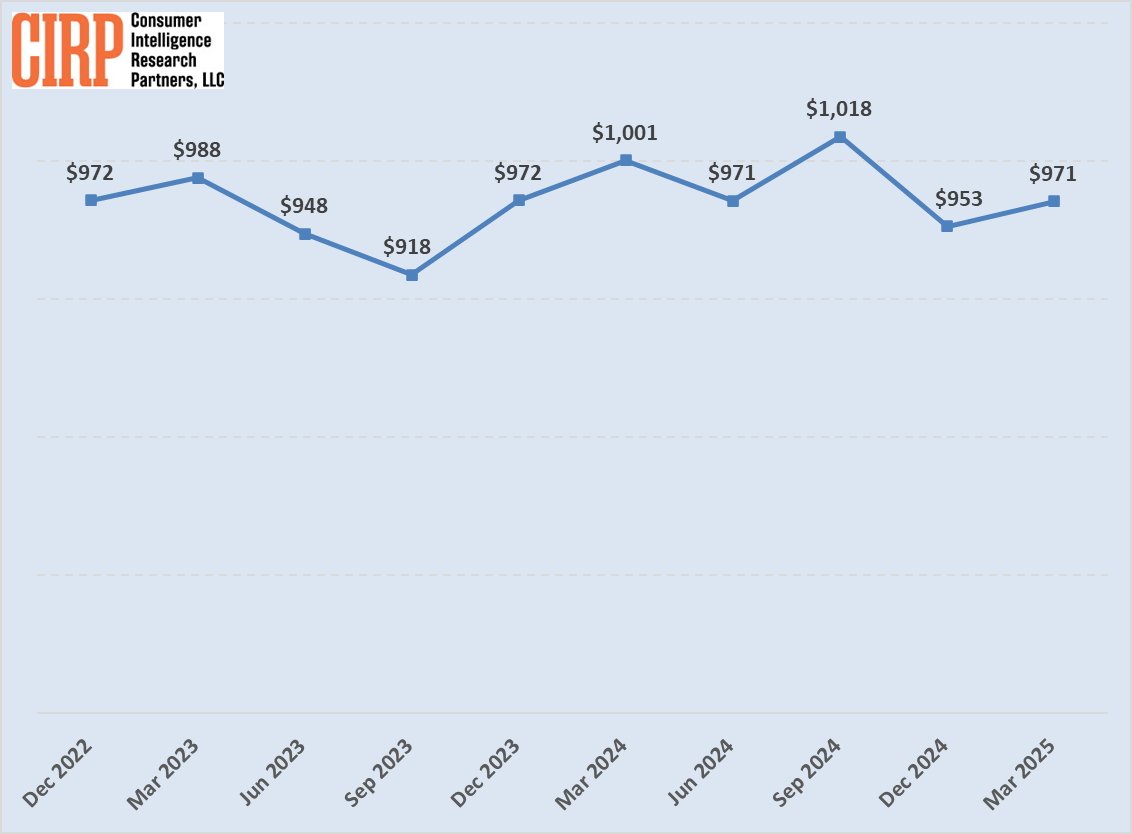The average price of iPhone models sold in the U.S. continues to rise as Apple adjusts its lineup, despite more buyers skipping the Pro models.
In the first quarter of 2025, the U.S. Weighted Average Retail Price (US-WARP) for iPhones rose to $971, up from $953 in the fourth quarter of 2024. That $18 increase reflects shifting dynamics in Apple’s lineup, according to new data from Consumer Intelligence Research Partners (CIRP).
Apple stopped reporting iPhone Average Selling Price in late 2018, after its fourth-quarter earnings call. Since then, analysts have relied on third-party metrics like US-WARP to track how much customers are actually paying.
Apple launched the iPhone 16e during the quarter, replacing the lower-priced iPhone SE. The iPhone 16e starts at a higher price, lifting the average. At the same time, the company discontinued the iPhone 14 and iPhone 14 Plus, further simplifying the product line.
However, the average increase was offset by fewer sales of the iPhone 16 Pro and iPhone Pro Max, as more customers chose the standard iPhone 16.
Fewer sales of iPhone Pro models isn’t unprecedented, but it stands out for happening earlier and more sharply than in past cycles. It suggests that fewer customers are finding the premium features of the iPhone 16 Pro lineup compelling enough to justify the higher price.
Storage upgrades also played a role. In previous quarters, buyers regularly paid more for additional capacity. This time, more users stuck with base storage, which put further downward pressure on the average.
iPhone 16e pushes out the iPhone SE
The iPhone 16e’s arrival signals a potential shift in Apple’s midrange strategy. Instead of continuing to offer the ultra-budget iPhone SE, Apple is steering buyers toward a more modern device that still maintains affordability.
The iPhone 16e lacks the premium features of the Pro models but offers a more modern design and feature set than the iPhone SE it replaces.
By raising the entry price of its lineup and streamlining the design across models, Apple can protect margins while appealing to cost-conscious buyers who still want a current iPhone experience.
The actual starting price of the iPhone 16e is higher than the iPhone SE, which contributed to the increase in US-WARP. But how customers respond once the iPhone SE and iPhone 14 models fully cycle out of the market remains to be seen.
Fewer buyers are choosing Pro models
The drop in iPhone Pro model sales suggests a faster-than-usual shift in consumer priorities after launch. Premium features like titanium frames and periscope cameras may not have sustained buyer interest beyond the early adopters.
While Pro models typically drive launch-period sales, fewer buyers appear to be upgrading to them as the cycle matures.
According to CIRP, the iPhone 16 Pro and iPhone 16 Pro Max made up 38% of U.S. iPhone sales in the first quarter of 2025, down from 45% for the iPhone 15 Pro lineup a year earlier. The decline supports a broader trend in the maturing smartphone market, where more buyers are prioritizing value over cutting-edge features.
A noticeable return to base storage models also affected the average price. With iPhones remaining expensive and upgrade cycles lengthening for most buyers, fewer are opting to pay extra for more storage.
That shift limits one of Apple’s more reliable pricing levers, especially outside the iPhone Pro segment where upsells are more common.
Why US-WARP matters for tracking Apple’s strategy
Apple stopped reporting global Average Selling Price after its fourth-quarter earnings call in 2018. Since then, analysts have relied on third-party metrics like US-WARP, which CIRP has tracked for over five years, to estimate pricing trends in the U.S.
Unlike ASP, US-WARP reflects the weighted average price paid by consumers at retail and excludes wholesale discounts and carrier subsidies. It doesn’t capture international sales or reflect Apple’s complete revenue picture.
However, it can provide a rough snapshot of how domestic model mix and pricing decisions influence what customers actually pay.
Apple’s midrange pivot could reshape the lineup
If the iPhone 16e performs well, Apple may continue refining its midrange offerings to balance design, performance, and price. That could mean fewer models at the bottom of the lineup and more emphasis on value without sacrificing brand identity.
It’s a delicate balancing act. Apple must hold its premium position while keeping entry points within reach for new buyers. The iPhone 16e may be the first of several iterative changes to strike that balance.
The data from the second quarter of 2025 will offer a clearer picture of how Apple’s latest strategy is performing, once discontinued models are fully out of the mix. For now, Apple’s average iPhone price is inching higher, but continued softness in Pro model sales and storage upgrades could make future gains harder to sustain.
The iPhone market may be settling into a new equilibrium. Consumers are still buying, but they’re spending more carefully. Whether Apple can keep nudging prices upward without losing share in the premium tier remains an open question.






